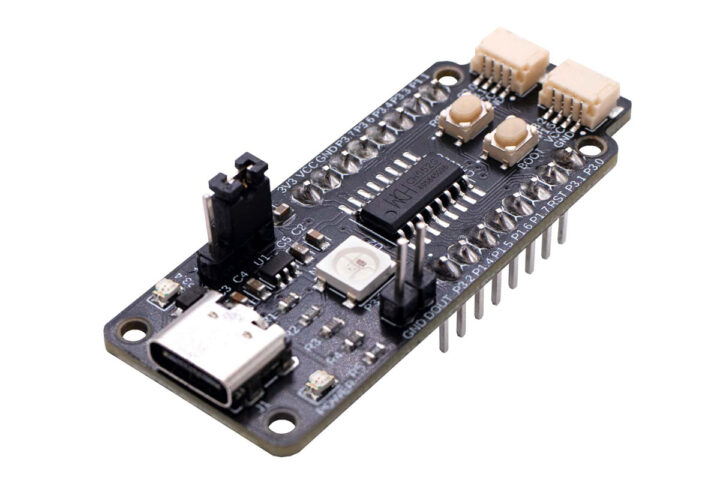The Cocket Nova CH552 is a cheap and versatile development board built around the CH552G MCU with an enhanced 8051 core clocked at 24MHz. Designed for beginners and hobbyists, this board features easy USB Type-C programming, onboard LEDs and a Neopixel RGB, reset and boot buttons, and Qwiic/STEMMA QT connectors for easy expansion. Additionally, it gives access to 17 GPIOs, PWM, ADC, and touch button capabilities. These features along with low-cost and standard breadboard compatibility make this development board suitable for learning and experimentation.
We have previously written about other products built around the CH552G/T microcontroller, namely a $10 Arduino-programmable keyboard and the Turing Smart Screen 3.5-inch USB Type-C information display. Users interested in inexpensive 8-bit MCU boards may also check out Electrodragon’s CH551 mini development board based on another MCU part of the CH55x family.
Cocket Nova CH552 development board specifications:
- MCU – WCH CH552 8-bit Enhanced USB single-chip MCU
- CPU – Enhanced E8051 core (compatible with MCS51 instruction set) clocked at 24MHz
- Memory
- XRAM – 1KB (with DMA support)
- iRAM – 256B
- Storage
- Code Flash – 16KB
- Data Flash – 128B (byte-level read/write)
- USB – USB 2.0 Type-C (12 Mbps) interface for power and programming
- Expansion I/Os
- Headers
- 17x GPIO pins
- 2x 8-bit PWM outputs
- 4x 8-bit ADC channels
- 6x Capacitive touch channels (up to 15 buttons)
- 2 x UART
- SPI interface
- Soft I2C
- 2x 1mm JST connectors (Qwiic, STEMMA QT compatible)
- Headers
- Misc
- Built-in LEDs
- Neopixel RGB on pin 3.3
- Standard LED on pin 3.4
- 2x Neopixel RGB LED headers
- Reset and Boot buttons
- Built-in LEDs
The dev board can be programmed with the Arduino IDE using the SDCC toolchain for the CH55x microcontroller. Instructions for setting up the compiler along with example code documentation and hardware resources are available on the Cocket Nova’s GitHub repository.
The Cocket Nova CH552 development board is priced at $6.00 and can be purchased from the UNIT Electronics Tindie store.
Debashis Das is a technical content writer and embedded engineer with over five years of experience in the industry. With expertise in Embedded C, PCB Design, and SEO optimization, he effectively blends difficult technical topics with clear communication
Support CNX Software! Donate via cryptocurrencies, become a Patron on Patreon, or purchase goods on Amazon or Aliexpress






